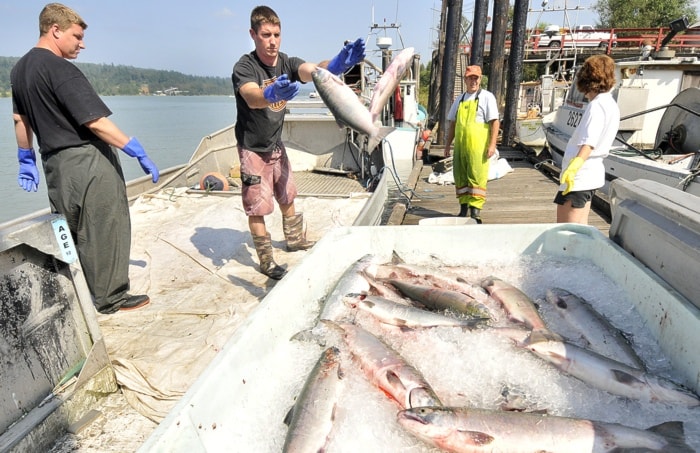Salmon watchers are hoping this is the year the troubled Fraser River sockeye run turns the corner on its disastrous collapse four years ago.
If returns come in as forecast, nearly 4.8 million sockeye will make their way up the Fraser this summer.
That's still well short of the longer term average of 8.6 million for this part of the four-year cycle.
But it would be a huge improvement from 2009, when more than 10 million salmon were expected and just 1.5 million arrived, prompting the federal government to appoint the Cohen Commission into the decline.
"Hopefully we'll get a run that's much improved relative to 2009," said Mike Lapointe, chief biologist for the Pacific Salmon Commission.
"If the run returns bigger and we're able to get some rebuilding, that will be very important for the sockeye moving forward. It will be definitely be more than what we had in the parent year that produced it."
Nobody is guaranteeing a commercial fishery yet.
The pre-season forecast shows a one-in-four chance of a Fraser sockeye run below 2.7 million, which would likely rule out commercial fishing, and a one-in-10 chance it will be as bad as 2009.
But after the Cohen inquiry failed to come up with a single cause or solution to the slide, observers like Lapointe would be happy to continue to see an improving trendline.
"We definitely did better in 2012 than 2008, we did better in 2011 than in 2007. If we can do better again in 2013 from 2009 we'll have gotten some rebuilding off of those three very low years."
Last year's sockeye return, while up, wasn't enough to allow commercial fishing or sports angling.
There are no concerns about 2014 – next year marks the return of the huge Adams River run, which came back with a stunning return of more than 30 million sockeye in 2010, meaning enough fish spawned to assure at least a healthy run.
The bulk of this year's sockeye are summer-run salmon, concentrated in two stocks – the Quesnel and Chilko lake systems.
Also coming back this year are pink salmon, which run on a two-year cycle.
Nearly nine million pinks are forecast to return – below average and down from the last couple of runs of more than 15 million.
Still, Lapointe said there are good odds of some commercial fishing for pinks, which typically fetch around 40 cents a pound, compared to $1.50 to $2 for sockeye.
"It's going to depend on how many pinks there are and how much interest there is [from the commercial fleet]."

Salmon named official fish emblem
The provincial government on Saturday declared Pacific salmon to be B.C.'s official fish emblem, in recognition of its high ecological, cultural and economic significance.
The designation captures all Pacific salmonids – sockeye, chinook, coho, pink and chum, plus ocean-going steelhead and cutthroat trout.
"With the epic migration of Pacific salmon from B.C.'s rivers and streams to the ocean and back, there is no symbol more iconic of British Columbia," Environment Minister Terry Lake said, adding they're integral to First Nations and often seen as indicators of overall ecosystem and wildlife health.
Salmon take a place among B.C. official symbols like the spirit bear (official mammal), western red cedar (official tree), Steller's jay (official bird), jade (official mineral and Pacific dogwood (official floral emblem).
